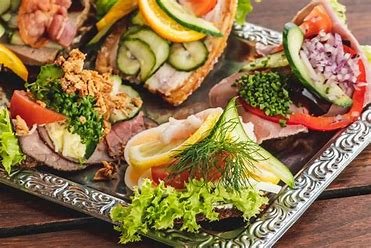Scandinavian cuisine, encompassing the food cultures of Denmark, Norway, and Sweden, is known for its simplicity, freshness, and reliance on locally sourced ingredients. These traditions reflect the region’s natural landscapes, climate, and cultural heritage.

1. Fresh and Seasonal Ingredients:
- Locally Sourced: Scandinavian cuisine emphasizes fresh, locally sourced ingredients, including fish, meats, berries, and root vegetables. Seasonal eating is a cornerstone of their culinary tradition.
- Foraging: Foraging for wild berries, mushrooms, and herbs is a popular activity, especially in Sweden and Finland, and these ingredients are often incorporated into meals.
2. Seafood:
- Fish and Shellfish: Due to the proximity to the sea, seafood plays a significant role in Scandinavian diets. Salmon, herring, cod, and shrimp are commonly used.
- Gravlax: A popular dish made from salmon cured with sugar, salt, and dill. It’s often served with mustard sauce and dark bread.
- Pickled Herring: Herring is often pickled and flavored with various herbs and spices, a staple in many traditional Scandinavian meals.
3. Dairy Products:
- Cheese: Scandinavian countries produce a variety of cheeses, including Sweden’s Västerbotten, Denmark’s Havarti, and Norway’s Brunost (brown cheese).
- Skyr: An Icelandic dairy product similar to yogurt, thick and creamy, often enjoyed with berries or honey.
4. Traditional Dishes:
- Smørrebrød: Danish open-faced sandwiches topped with ingredients like pickled herring, liver pâté, cold cuts, and cheeses. They are artistically arranged and often enjoyed for lunch.
- Meatballs (Köttbullar): Swedish meatballs served with creamy gravy, lingonberry sauce, and mashed potatoes. A beloved dish in Sweden.
- Rømmegrøt: A traditional Norwegian porridge made with sour cream, milk, flour, and butter, often served with sugar and cinnamon.
5. Breads and Pastries:
- Rye Bread: Dense and hearty rye bread (rugbrød) is a staple in Scandinavian diets, particularly in Denmark. It’s often used for smørrebrød.
- Cinnamon Buns (Kanelbullar): Sweet, spiced buns rolled with cinnamon and sugar, popular in Sweden, especially during Fika (coffee break).
6. Preserves and Pickling:
- Berry Preserves: Preserving berries like lingonberries, cloudberries, and blueberries is common, used as toppings for pancakes, waffles, and meats.
- Pickles: Pickling vegetables, especially cucumbers and beets, is a traditional method of preservation that adds tangy flavors to meals.
7. Cultural Practices:
- Fika: A Swedish tradition of taking a break to enjoy coffee and pastries with friends or colleagues. It’s an important social ritual that promotes relaxation and connection.
- Midsummer Celebration: Celebrated in June, Midsummer involves traditional foods like pickled herring, potatoes, and strawberries, accompanied by dancing and singing around the Maypole.
8. Modern Influences:
- New Nordic Cuisine: A modern culinary movement that emphasizes local, sustainable, and seasonal ingredients. Chefs like René Redzepi of Noma in Denmark have popularized this approach, creating innovative dishes that highlight the natural flavors of the region.
Conclusion:
Scandinavian food traditions offer a delightful blend of simplicity, freshness, and respect for nature. From hearty seafood dishes to sweet pastries and communal rituals like Fika, these traditions reflect the region’s cultural heritage and way of life.
